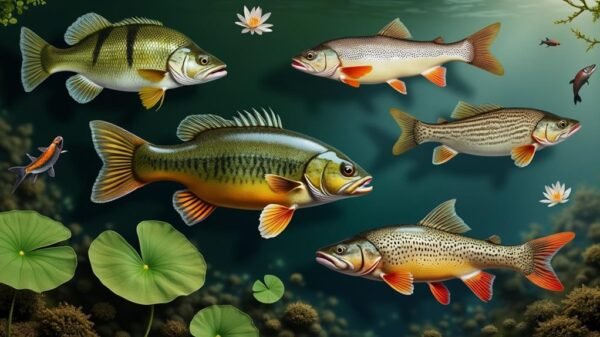Identifying freshwater fish species is crucial for you as an angler and a steward of our ecosystems. Knowing different species improves your fishing tactics and helps you make informed decisions. Each species, like the aggressive Largemouth Bass or the colorful Sunfish, has unique characteristics that can change your experience on the water. Understanding these differences also contributes to habitat protection and the sustainability of fish populations. Use reliable field guides or apps to assist you in this exploration. The more you learn about the fish around you, the more fulfilling your fishing expeditions will become. Keep exploring for valuable insights!
Importance of Fish Identification
Identifying fish is essential for both ecological preservation and leisure fishing. When you can distinguish between various species, you gain valuable insights that empower you to make educated decisions. For instance, understanding the differences between coldwater fish like trout and warmwater species such as largemouth bass can significantly enhance your fishing tactics. Imagine casting your line into a shimmering lake, fully aware of your target species. This connection with nature enriches your fishing journey.
Fish identification is also vital for conservation efforts. By recognizing the fish species in your local waters, you contribute to habitat protection and ecosystem preservation. If you accidentally catch a threatened species, knowing how to identify it can lead you to make responsible choices, like releasing it back into its habitat. This awareness not only supports biodiversity but ensures future generations can enjoy the same outdoor experiences you cherish.
Additionally, understanding fish species fosters camaraderie among anglers. Sharing insights and experiences about local fish can lead to more fruitful fishing trips and strengthen friendships. Therefore, take the time to familiarize yourself with the fish in your area. Use resources like the "FishBrain" app or a field guide, and embark on your exploration! The more you learn, the more you can appreciate and enjoy the freedom that fishing provides. Your adventures depend on it.
Common Freshwater Fish Species

When you explore freshwater habitats, you'll encounter various fish species, each with distinct traits and behaviors. You might find the energetic Largemouth Bass, known for its aggressive strikes and swift movements. These fish often reside near structures like rocks or fallen trees, making them exciting targets for anglers. Largemouth Bass are among the most prevalent aquatic species worldwide, which enhances their appeal.
In addition, there's the Catfish, recognized for its whiskered face and bottom-feeding nature. These fish thrive in murky waters and can reach impressive sizes, offering an exhilarating catch for fishermen.
Don't forget the vibrant Sunfish, commonly found in ponds and lakes. Their bright colors can elevate any fishing outing. If you're navigating rivers, you may spot Trout, which are valued for their subtle flavors and agility in fast currents.
As you immerse yourself in this environment, get to know the familiar species in your region. Understanding what to expect can enhance your fishing experience and help you appreciate the rich ecosystems around you. Each fish brings a unique story, and grasping these species opens up new avenues for freedom in your outdoor adventures. So prepare your gear, venture out, and relish the pursuit.
Key Identification Characteristics

To identify freshwater fish species, focus on key characteristics. Start with the body shape; is it elongated or rounded? This can help narrow down your choices. Consider the habitat as well, since species like the northern pike and trout prefer specific environments.
Next, examine the coloration and patterns. Some fish exhibit bright colors, while others have muted tones. For instance, the rainbow trout displays a vibrant spectrum, whereas catfish tend to have a more uniform appearance.
Pay attention to the fins. The number, size, and shape of the fins provide important clues. Certain species have long, flowing fins, while others possess shorter, sturdier ones. Additionally, look at the mouth shape; fish like the largemouth bass have broad mouths, in contrast to the smaller, rounded mouths of sunfish.
Tools for Beginners

Understanding the key features of freshwater fish is just the start; having the right equipment can greatly enhance your fish identification skills. Begin with a reliable field guide, like the "Freshwater Fish Identification" guide by Paul Smith. These books contain vivid illustrations and informative descriptions, helping you connect what you observe with the information presented.
Experimenting with various fishing methods, such as fly fishing or spin fishing, can deepen your knowledge of the habitats that different species prefer, aiding your identification efforts.
Additionally, investing in a sturdy pair of Oakley polarized sunglasses will help you see beneath the water's surface, making it easier to spot fish. A Canon digital camera or an Apple smartphone can be useful for taking photos, allowing you to research species when you're back on land.
Don't forget the importance of a notebook. Jotting down your observations will help you remember details and patterns, enhancing your identification skills as you progress.
Lastly, consider using online platforms and applications like FishBrain or iNaturalist. These resources often feature identification tools where you can input specific traits and receive instant results. This modern approach can make learning both fun and engaging. By equipping yourself with these tools, you'll be well on your way to becoming a proficient freshwater fish identifier, ready to explore and enjoy your aquatic experiences.
Responsible Fishing Practices

Responsible fishing practices play a crucial role in maintaining aquatic ecosystems and ensuring sustainable fish populations for future generations. When anglers venture out to fish, they have the opportunity to safeguard waterways and support the conservation of various species, such as largemouth bass and rainbow trout. It is important to familiarize oneself with local regulations and limits, as these guidelines exist for a purpose. Utilizing catch and release methods can promote thriving fish populations. If a fish is kept, only take what is necessary for consumption.
Selecting appropriate equipment is vital. A properly matched fishing rod and reel can reduce stress for the caught fish. When handling aquatic life, it is recommended to wet hands prior to contact to preserve their protective slime layer, which is vital for their health and survival.
Additionally, it is essential to respect the environment. Avoid fishing in designated spawning zones, and be proactive in cleaning up any litter encountered during the outing. These actions not only benefit fish but also enhance the overall fishing experience for all who cherish our natural waterways.



























